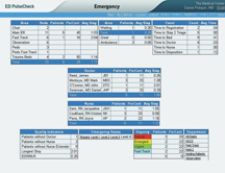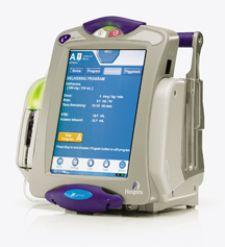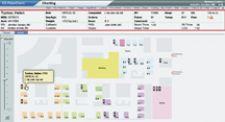
Picis' ED PulseCheck tracks and manages patients
White boards and charts? Who has the time? Missing the notation of the length of a laceration? Why lose eligible billing? Unsure of a certain allergy or drug interaction in a critical care situation? Get all the reimbursement you can! Emergency department information systems (EDIS) are taking some of the stress, danger and documenting mistakes caused by an intense work environment out of emergency departments around the country.
“[EDIS] are sort of the hub of good patient care,” said Steve Pregulman M.D., global medical director of Device Development & Medical Services at Hospira. “By good I mean informed by all the various pieces of knowledge and information that historically have been scattered around hospitals on paper and in cubby holes and in lab reports in some file cabinet that were not necessarily available to a clinician at the time he or she may have needed, be it when they were writing an order or more importantly when they were administering a medication.”
“Lately there has been a lot more emphasis on the emergency department,” said Mark D. Crockett, M.D., F.A.C.E.P. and president of the Emergency Care Division of Picis “Our volumes are up 20 percent and the environment has changed. EDIS help the hospital handle that load and make sure that people are taken care of safely.”
EDIS are capable of automating clinical documentation, tracking patient location, alerting physicians of allergy risks and possible dangers associated with mixing medication and wrapping a patient’s medical charts into one easy-to-read file, all which can be viewed from anywhere in the hospital.
“[With EDIS] nurses have a lot more time on the backend because we aren’t trying to find charts,” said Lois Vandercook RN, EDIS administrator at Henry Ford Health System. “This saves us from having to find pieces of paper, results are right there and everything is right at our fingertips.”
According to The U.S. Department of Health and Human Services Agency for Healthcare Research and Quality, American nurses spent thirty percent less time on documentation following the installation of an EDIS, with most of that saved time going toward direct patient care.
In a busy critical care setting, a major problem and safety issue occurs when a patient cannot be located. Many EDIS, including the Picis ED PulseCheck, track and manage patients throughout their stay, allowing physicians to locate them via computer screen. Systems such as the ED PulseCheck and Patient Care Technology Systems’ Amelior ED provide a customizable floor plan, tailored to each hospital, of every patient in the ED, revealing important information about that patient’s situation and location with the click of a button. This makes finding and treating a patient much easier and faster, as opposed to standard methods of hurrying around the department, checking bathrooms or other rooms for a missing or disoriented individual who may be in need of medication or testing. According to Vandercook, patient tracking also makes it easier for other departments, such as radiology, to pick up patients and drop them off without having to ask a nurse for their location.
“[Patient Tracking] is amazing,” said Vandercook. “We no longer have lost patients. When we are full we actually use our halls and walls and it was really hard to determine where patients were. We would just go down the hall calling their names and now we can tell exactly where every single patient is.”
Whether daily patient volume exceeds 200 or 20, safety is always a top priority. EDIS are capable of assisting in life-saving medical decisions, including alerting physicians of patient allergies and drug-to-drug interactions. While a physician usually has to check with a patient to see what their allergies may be, with an EDIS installed, he or she only has to check the patient’s file in order to immediately access previous records and medical information.
“[With an EDIS] I have the ability to look at a patient’s previous information and know exactly what their current situation is and that could be life critical information,” said Dr. Crockett, who is an attending physician at Morris Hospital in Morris, IL.
Dosing Errors Dramatically Reduced
Hospira has addressed the problem of dosing errors caused by manual procedures with its Symbiq and Plumb A infusion pumps that can work alone or in conjunction with an EDIS, communicating with the IV pumps and providing a safety layer so the nurse who is programming the pump by hand won’t program outside of the hospital’s established limits.
“A fair amount of literature shows adverse drug events and errors that are occurring in the U.S. today and the numbers are staggering,” said Dr. Pregulman. “We want to have the ultimate safety software to make sure that the nurse is not inadvertently overprogramming, overdosing or giving the wrong medication. We see errors in the logs of the pumps all the time, quite often it’s a tenfold decimal error or a transcription error, which are now are quite catch-able.”
Hospira’s Plum A system also incorporates auto-programming, removing the need for the nurse to use his or her fingers to program the infusion pump. With Plumb A , the nurse does not have to select the drug, which is a place for error, or put in the dose. Instead, bar-code technology takes the order out of the EDIS and sends it to the pump. The nurse then views and confirms the order and the dose is administered. After administration, the dose information is logged and sent back to the EDIS for documentation, saving time for the nurse as well as providing an extra layer of safety for the patient.
Unprecedented Revenue Returns
Patients are not the only ones benefiting from the installation of an EDIS. The traditional method of documenting involved recording coded procedures by hand. This left many undocumented expenses, resulting in money lost by a hospital. When it comes time to submit a bill, if a procedure code does not appear on the document, it in essence, never happened.
“There are a lot of services that nurses are providing that really reflect the kind of care that they are giving in the emergency department that they tend not to document,” said Dr. Crockett who uses the Picis PulseCheck EDIS. “It’s very difficult to sort out what is a nursing procedure and can be billed as APC versus what is a service that provides an additional amount to the level of service.”
The PulseCheck automatically calculates all billing information, making sure nurses can chart the way they normally do and then uses financial algorithms in the background to make sure that the appropriate billing goes from the ED.
Because both Medicaid and Medicare billing are highly sensitive to the level of service, easy-to-make mistakes, such as inappropriately billing a level three instead of a level five or a level four instead of critical care based on the documentation provided, could be costing hospitals millions of dollars in revenue.
“Even in hospitals where I was told by the chief financial officer that there would be no net additional benefit to the hospital [after installation of an EDIS] we have seen literally millions of dollars returned,” said Dr. Crockett.
Though installation and implementation of an EDIS brings about monumental change in the way an ED and its nurses and physicians see and help their patients, the process itself is not as hard as it may seem.
According to Vandercook, her department took only six weeks to be completely comfortable with its EDIS after extensive training sessions prior to and during the week of installation, doubling up staff for the beginning of implementation and having Picis representatives on site to help out.
All in all, the benefits of EDIS are showing strongly in patient outcome and ED procedure. With EDIS growing every year to include more and more components of the ED, bedside care time is rising, mistakes are shrinking and hospitals are seeing helpful returns thanks to better documentation. According to Vandercook, “No one would want to go back to paper at this point!”



